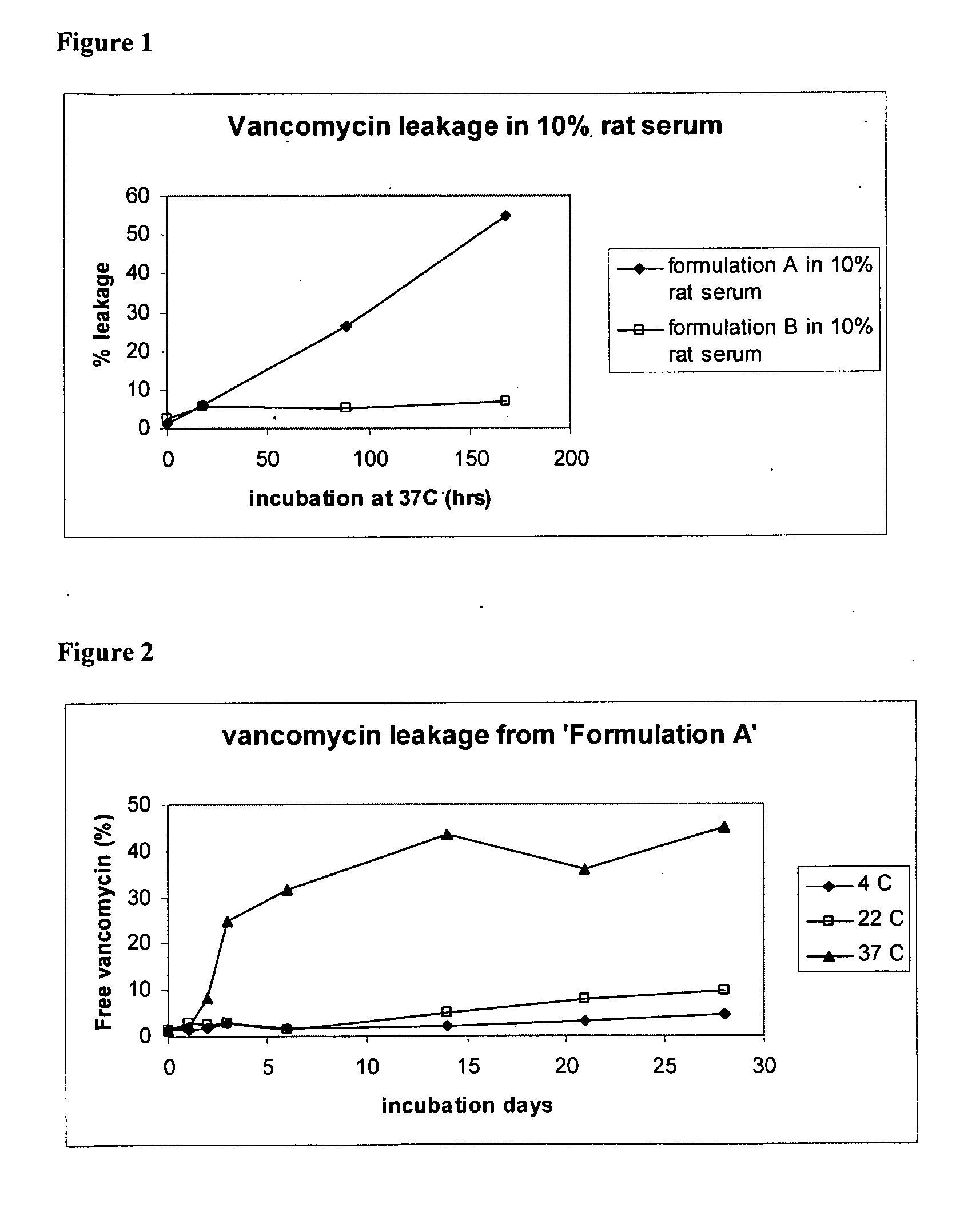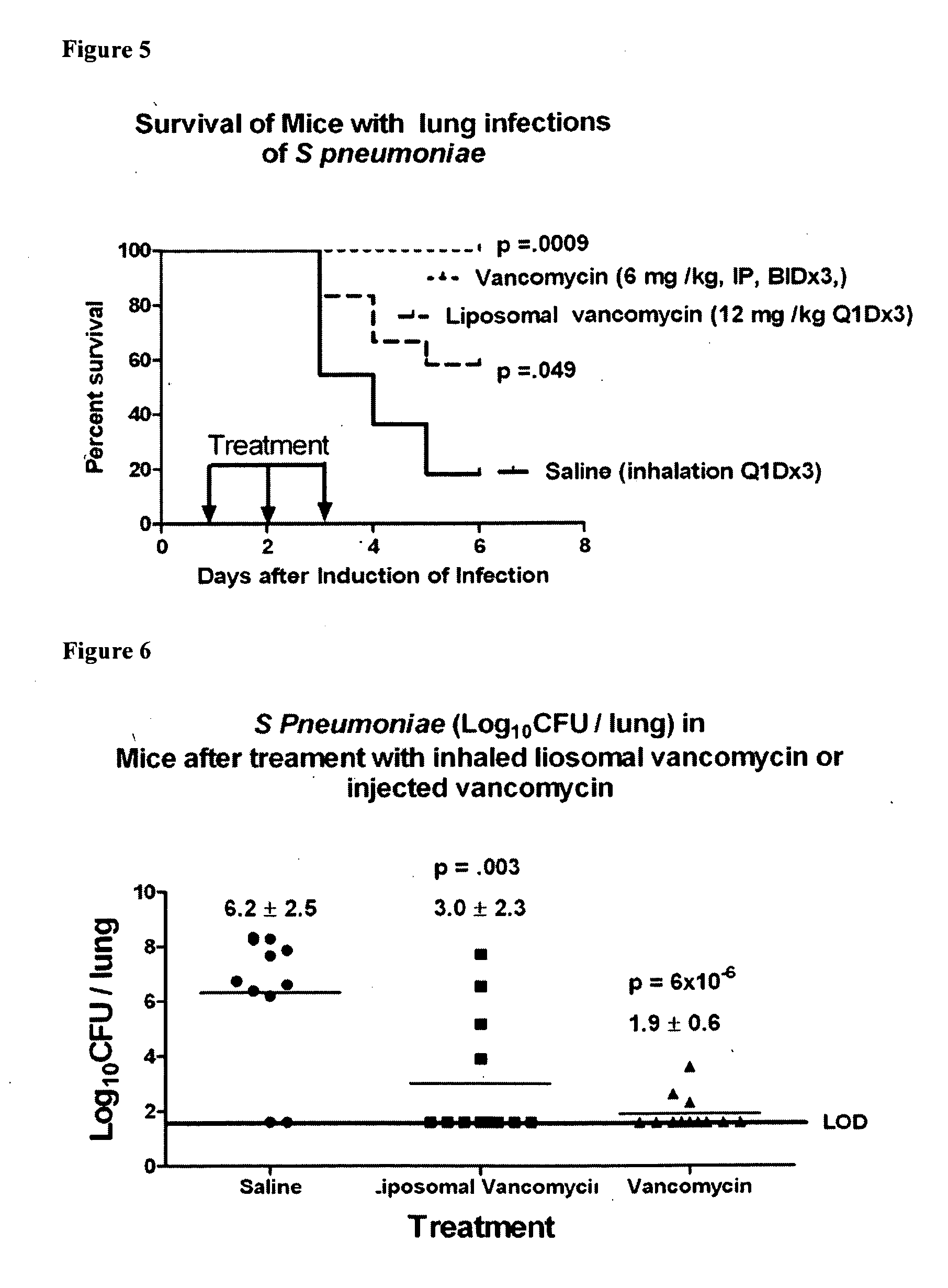Methods of Treating Pulmonary Disorders using Liposomal Vancomycin Formulations
a technology of liposomal vancomycin and pulmonary disorders, which is applied in the direction of antibacterial agents, drug compositions, peptide/protein ingredients, etc., can solve the problems of toxicity concerns, mucus becomes stuck and accumulates in the airways, weakening and widening the passages, etc., and achieves the effect of reducing pulmonary infection, reducing pulmonary infection, and shortening the time period
- Summary
- Abstract
- Description
- Claims
- Application Information
AI Technical Summary
Benefits of technology
Problems solved by technology
Method used
Image
Examples
example 1
Liposomal Vancomycin Formulations
[0097]Liposomal vancomycin formulations were prepared using the methods described above. Specifically, the alcohol used in the lipid stock solution was ethanol. The alcohol used in the aqueous / alcoholic vancomycin stock solution was also ethanol. Formulations were prepared using DPPC, DPPC / CHOL, DOPC / CHOL and POPC / CHOL. The lipid to drug ratios of vancomycin produced using these methods were very low, as shown in Table 1. Concentrations of vancomycin are also shown in Table 1.
TABLE 1Liposomal vancomycin formulationsVancomycinLipid / drugconcentrationLipid Composition(wt / wt)(mg / ml)DPPC0.2949.64DPPC0.2764.53DPPC0.1958.64DPPC0.63123.02DPPC0.5550.11DPPC0.6343.29DPPC0.4164.28DPPC0.2576.77DPPC / CHOL(4 / 1 wt)0.8546.85DPPC / CHOL(2 / 1 wt)2.338.94DPPC / CHOL(2 / 1 wt)6.110.36DPPC / CHOL(2 / 1 wt)4.6325.54DOPC / CHOL(4 / 1 wt)4.9312.18POPC / CHOL(4 / 1 wt)5.488.81
[0098]Additional characteristics (mean particle diameter and pH) of selected liposomal vancomycin formulations and the co...
example 2
Degradation Study Under Biological Conditions
[0099]The liposomal formulation of the present invention prevents degradation of vancomycin in a biological environment. Vancomycin is known to degrade to two Crystal Degradation Products (CDP), known as CDP-m and CDP-M. In order to evaluate the stability of the liposomal vancomycin formulations, two formulations (A and B) were diluted into 10% rat serum and incubated at 37° C. and tested for leakage and degradation to CDP using HPLC. An exemplary Formulation A contains vancomycin in a DPPC liposome, as described above. Formulation B contains vancomycin in a DPPC / CHOL liposome.
[0100]Both formulations showed less degradation of vancomycin encapsulated in the liposome compared to vancomycin outside of the liposome. (Table 3). Thus, the liposomal formulation liposome appears to reduce the degradation from vancomycin to CDP, especially during the first 4 days of incubation. Formulation A liposome, which contains DPPC, prevented CDP formation ...
example 3
Drug Release Profile of Formulations A and B
[0101]Formulas A and B were incubated in rat serum at in vivo temperature (37° C.). Formulation A shows fast drug release during incubation over a period of 150 hours, while formulation B showed very little release of any drug. (FIG. 1)
PUM
| Property | Measurement | Unit |
|---|---|---|
| concentration | aaaaa | aaaaa |
| concentration | aaaaa | aaaaa |
| mean particle size | aaaaa | aaaaa |
Abstract
Description
Claims
Application Information
 Login to View More
Login to View More - R&D
- Intellectual Property
- Life Sciences
- Materials
- Tech Scout
- Unparalleled Data Quality
- Higher Quality Content
- 60% Fewer Hallucinations
Browse by: Latest US Patents, China's latest patents, Technical Efficacy Thesaurus, Application Domain, Technology Topic, Popular Technical Reports.
© 2025 PatSnap. All rights reserved.Legal|Privacy policy|Modern Slavery Act Transparency Statement|Sitemap|About US| Contact US: help@patsnap.com



